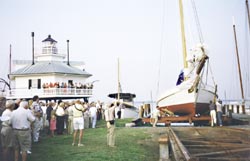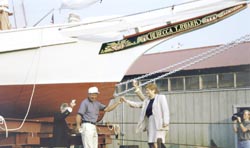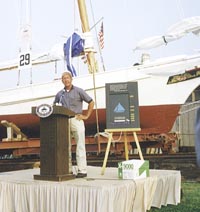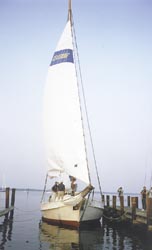Skipjacks Sail into a Brighter Future
 by M.L. Faunce by M.L. Faunce
Rebecca Ruark hit bottom on the way to her relaunching. Now other skipjacks won’t have to fall so far.
Maryland’s aging and fragile skipjack fleet moves one step farther from oblivion thanks to recommendations by the Save our Skipjacks Task Force of the Maryland Commission for Celebration 2000.
The timing could not be better.
At the millennium, only 12 or so remaining commercial skipjacks actively dredge the Chesapeake for oysters. Back in their heyday in the 1880s, some 700 of the sailing vessels — some say many more — plied Bay waters, plucking plump bivalves from bounteous stocks.
Surviving skipjack captains are fighting the good fight — against the rough seas of age and deterioration and the hard passage of scarce loans and insurance. Even access to the livelihood, oysters, has been restricted.
Now, serendipitously, much of that may change. Thanks is due as much to the bad luck of one poor skipjack captain as to the creative problem solving of Maryland officials, historians, preservationists and skipjack captains.
Rebecca T. Ruark’s Silver Lining
On a dark, dreary day last November, the Rebecca T . Ruark, oldest skipjack afloat and queen of the fleet, sank in a freak storm near the mouth of the Choptank River. What seemed a disaster has revealed a silver lining. . Ruark, oldest skipjack afloat and queen of the fleet, sank in a freak storm near the mouth of the Choptank River. What seemed a disaster has revealed a silver lining.
Wade Murphy, third generation skipjack captain and owner of the Rebecca, stood on board watching “the biggest sea I’ve ever seen in my life.” He cast off the 70 bushels of oysters caught that day — “a whopping harvest for our times,” he later recalled. But he did not lose his faith and love for the 100-year-old vessel.
Murphy’s faith was well placed. As news of the disaster spread, so did commitment to save the oldest boat on the Chesapeake. With unaccustomed speed, the state of Maryland ponied up the money to raise the old skipjack. With his ship rescued from the muck, Captain Wade set out doing what he does best: talking up the Rebecca. From up and down the Bay, along both shores, donations followed Murphy’s Pied-Piper performance, trickling — if not flowing — in to restore the queen of the fleet.
“It’s too late for me,” said Murphy of the recommendations by the Skipjack Task Force. “But it will help the other captains. The Tilghman boats are in fair shape, but Deal Island boats need this help now.”
Rebecca Relaunched
On a perfect evening in June filled with wine, song, gentle breezes, applause and accolades, the Rebecca was returned to her rightful place. Perched on the marine railway at the Chesapeake Bay Maritime Museum in St. Michael’s, she took 10 minutes to gently slide back into the water.
The preceding seven-month journey to restore the Rebecca was deemed nothing short of a miracle by the captain with 44 years of sailing experience on the Bay, who could now admit “on that November day I thought I lost her.” On this night, he professed himself “happier now than I have ever been.”
In front of hundreds of museum members, Captain Wade gave thanks where thanks was due:
To museum executive director John Valliant, for the support “to fix it right. If it wasn’t for the Maritime Museum, I wouldn’t be here,” Wade said.
To James McLean and Zoe Piendak of the Governor’s Office of Business Advocacy, as “true advocates.”
To the McCormick and Co. Inc. for the gleaming new sail that, unfurled, just happens to tout “Old Bay Seasoning.”
And to all the many individuals w ho gave money or time to help restore his skipjack. ho gave money or time to help restore his skipjack.
Remembering how many forces had united in the journey from disaster to resurrection, Valliant said “People are more important than boats.” Then he announced more good news: Chesapeake Bay Maritime Museum will become the Bay’s center for skipjack restoration.
With the Rebecca’s restoration nearly complete, her new day is dawning. Soon, the Coast Guard will climb aboard the vessel to perform stability tests to determine the number of passengers the vessel will be certified to carry. Those 30 to 40 approved passengers will this very summer sail and dredge oysters on the resurrected queen of the fleet. As always, she’ll be captained by the resilient, resourceful man many call the Pied Piper, Tom Sawyer, even P.T. Barnum of skipjacking.
Seeing Murphy standing on the deck of his fully restored skipjack as champagne tricks down her hull, who could argue?
Saving More Skipjacks
Captain Ed Farley, president of Maryland Sail Dredgers Association, recalls the irony of getting a phone call the day before the Rebecca sank, asking for his ideas to help preserve the skipjack as a Maryland treasure. Farley was enthusiastic about Maryland 2000’s proposal. “It was important not just to develop a plan to preserve the skipjack but also to save the working fleet.”
Farley, like other skipjack captain owners, has had to put his own money up front for repairs and maintenance. He mortgaged his home seven years ago to get his skipjack, the H.M. Krentz, in shape for Coast Guard certification to carry passengers. Now he offers cruises to supplement his income when oyster season closes.
As Valliant says, “Watermen are extremely adaptable — they have to be.”
The H.M. Krentz is “well built and maintained,” says Farley, but the 45-year-old vessel still faces major repairs.
One of the Taskforce’s recommendations — low interest rates through th e Maryland Historical Trust — “will help me and others since commercial loans are beyond the financial capability of most skipjacks,” Farley says. e Maryland Historical Trust — “will help me and others since commercial loans are beyond the financial capability of most skipjacks,” Farley says.
But Farley was disappointed that the General Assembly lowered a museum funding request that would have helped skipjack captains. So there’s a tinge of envy in his voice when Farley alludes to the “clever marketing” idea Captain Wade came up with as a fundraiser: To cut up his old mast into blocks, then have them carved into decoys for sale. “There’s one born every minute,” Farley reflected, on the idea he admitted was both “creative and successful.”
Recommendations by the Skipjack Task Force include:
Flexible power-use days and standardizing oyster season for all.
This means that skipjacks harvesting oysters commercially will be able to select any two days except Saturday and Sunday to dredge under power. Currently, they can only dredge under power — and then only with the help of a push-boat — on Monday and Tuesday.
“If weather is inclement or conditions poor, you are just out of luck for that day,” says Farley, who is also a member of the task force.
A uniform harvesting season would allow commercial skipjacks to begin harvesting oysters at the same time other oystermen do.
Expanding the existing marine railway at the Calvert Marine Museum in St. Michael’s.
“There, skipjacks will be repaired at “drastically reduced cost to the vessel owner,” says Marc Apter of Maryland 2000. The taxpaying public gets to observe repairs to boats on site by craftsmen using “age old technology to return boats to their former glory.”
This recommendation Murphy considers among the best.
Establish a Skipjack Restoration Center at the Museum.
This recommendation came from museum executive director John Valliant, who wanted the museum to become Maryland’s central location to restore, repair and document the vessels. Besides expanding the marine railway, the program would include an apprenticeship program.
Finding funds for the Center is another thing.
In the last General Assembly session — a year of record surpluses — “everybody and his brother were at the trough looking for funds,” says Valliant, whose museum didn’t fare so well in its request.
In the General Assembly’s “infinite wisdom,” Valliant says his museum received only $400,000 of some $900,000 requested for numerous projects, including expansion of the existing marine railway. “But,” he says, “we are working hard and quietly at other sources. Another pool of funds we might be able to tap is the state’s Waterway Improvement Fund.
“I’m confident it will all come together,” Valliant says.
Restoring and repairing skipjacks.
This recommendation seems more assured. “If all goes well,” Valliant says, work could begin as soon as July 1 with funding from the Maryland Historical Trust.
Five shipwrights who maintain the museum’s fleet of boats will train three apprentices already schooled in boat building to work on skipjacks.
The decision of which vessels to be chosen for repair and restoration will be up to the skipjack captains, including Farley and Russell Dize of the Skipjack Task Force. Valliant says the museum is awaiting this consensus from the fleet.
“There’s nothing better than a boat launching,” Valliant told Bay Weekly. “Nothing could be more pleasant.”
And so it was, on a perfect evening in June, with hope on the horizon that a Chesapeake Bay fleet of old will sail into the future.
Copyright 2000
Bay Weekly
|